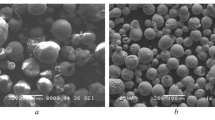Ultrafine WC–Co composite powders are synthesized via spray conversion method. The effect of carbon source (organic carbon and carbon black) and atmosphere (H2 and N2) on the composite powders is investigated in terms of phase composition, particle size distribution, morphology, and carbon content, including the total carbon and free carbon using X-ray diffraction, particle size analyzer, scanning electron microscope, and infrared carbon and sulfur analyzer. The results show that using organic carbon or carbon black and H2 or N2 has its own advantages and disadvantages. Therefore, carbon source and the atmosphere can be chosen according to the application of the composite powders, i.e. cemented carbides and thermal spraying.








Similar content being viewed by others
References
R. M. Raihanuzzaman, M. Rosinski, Z. Xie, and R. Ghomashchi, “Microstructure and mechanical properties and of pulse plasma compacted WC–Co,” Int. J. Refrac. Met. Hard Mater., 60, 58–67 (2016).
A. Ghabchi, T. Varis, E. Turunen, et al., “Behavior of HVOF WC–10Co4Cr coatings with different carbide size in fine and coarse particle abrasion,” J. Therm. Spray Technol., 19, 368–377 (2010).
S. Emani, C. Wang, L. L. Shaw, and Z. Chen, “On the hardness of submicrometer-sized WC–Co materials,” Mater. Sci. Eng. A, 628, 98–103 (2015).
S. I. Cha, S. H. Hong, G. H. Ha, and B. K. Kim, “Microstructure and mechanical properties of nanocrystalline WC–10Co cemented carbides,” Scripta Mater., 44, 1535–1539 (2001).
K. Jia, T. E. Fischer, and B. Gallois, “Microstructure, hardness and toughness of nanostructured and conventional WC–Co composites,” Nanostr. Mater., 10, 875–891 (1998).
M. H. Enayati, G. R. Aryanpour, and A. Ebnonnasir, “Production of nanostructured WC–Co powder by ball milling,” Int. J. Refrac. Met. Hard Mater., 27, 159–163 (2009).
L. E. McCandlish, B. H. Kear, and B. K. Kim, “Processing and properties of nanostructured WC–Co,” Nanostr. Mater., 1, No. 2, 119–124 (1992).
S. I. Cha, S. H. Hong, G. H. Ha, and B. K. Kim, “Mechanical properties of WC–10Co cemented carbides sintered from nanocrystalline spray conversion processed powders,” Int. J. Refrac. Met. Hard Mater., 19, 397–403 (2001).
K. Mohan and P. R. Strutt, “Microstructure of spray converted nanostructured tungsten carbide–cobalt composite,” Mater. Sci. Eng. A, 209, 237–242 (1996).
L. E. McCandlish, B. H. Kear, and S. J. Bhatia. Spray Conversion Process for the Production of Nanophase Composite Powders, Patent 5352269 United States. Appl. Jul 09, 1991; Publ. Oct 04, 1994.
A. Mukhopadhyay and B. Basu, “Recent developments on WC-based bulk composites,” J. Mater. Sci., 46, 571–589 (2011).
H. Lin, B. Tao, J. Xiong, et al., “Tungsten carbide (WC) nanopowders synthesized via novel core–shell structured precursors,” Ceram. Int., 39, 2877–2881 (2013).
Q. Yang, J. Yang, H. Yang, et al., “Synthesis and characterization of WC–Co nanosized composite powders with in situ carbon and gas carbon sources,” Met. Mater. Int., 22, 663–669 (2016).
G. H. Ha and B. K. Kim, “Synthesis of ultrafine WC–Co powder by mechanochemical process,” Powder Metallurgy, 45, 29–32 (2002).
C. Tang, M. Yi, and X. Tan, “Preparation of WC–Co composite powder by spray-drying and direct carbonization method,” Powder Metall. Technol., 28, 279–283 (2010).
Y. Jin, B. Huang, C. Liu, and Q. Fu, “Phase evolution in the synthesis of WC–Co–Cr3C2–VC nanocomposite powders from precursors,” Int. J. Refrac. Met. Hard Mater., 41, 169–173 (2013).
U. Kanerva, J. Lagerbom, M. Karhu, et al., “Synthesis of nano-WC from water soluble raw materials: Effects of tungsten source and synthesis atmosphere on chemical and phase structure evolution,” Int. J. Refrac. Met. Hard Mater., 50, 65–71 (2015)
U. Kanerva, M. Karhu, J. Lagerbom, et al., “Chemical synthesis of WC–Co from water-soluble precursors: The effect of carbon and cobalt additions to WC synthesis,” Int. J. Refrac. Met. Hard Mater., 56, 69–75 (2016).
J. Lü, J. Yang, H. Chen, et al., “Preparation of nanocrytalline WC–Co composite powder by spray-drying and low temperature reduction-carbonization process,” Mater. Sci. Eng. Powder Metall., 18, 835–839 (2013).
A. Kumar, K. Singh, and O. P. Pandey, “Reduction of WO3 to nano-WC by thermo-chemical reaction route,” Physica E: Low-Dimen. Sys. Nanostr., 41, No. 4, 677–684 (2009).
R. Liu, D. Yi, and J. Li, “Study of preparing nanocrystalline WC powder,” J. Mater. Sci. Eng., 24, No. 3, 418–422 (2006).
J. Luo, Z. Guo, T. Lin, and X. Hu, “Study on removing free carbon of nanosized WC by heat processing in flowing hydrogen atmosphere,” Trans. Mater. Heat Treat., 28, No 1, 38–41 (2007).
J. Ruan and P. Huang, The Principle of Powder Metallurgy, Mechanical Industry Press, Beijing (2012).
Acknowledgements
Zhonghua Wang is grateful to Mr. Jie Wu for his assistance in conducting experiments.
Author information
Authors and Affiliations
Corresponding author
Additional information
Published in Poroshkova Metallurgiya, Vol. 57, Nos. 3–4 (520), pp. 3–14, 2018.
Rights and permissions
About this article
Cite this article
Wang, Z., Shang, G., Lü, J. et al. Investigation of Carbon Source and Atmosphere During Reduction–Carbonization Process of Synthesizing WC–Co Composite Powders Via Spray Conversion Method. Powder Metall Met Ceram 57, 127–137 (2018). https://doi.org/10.1007/s11106-018-9960-6
Received:
Published:
Issue Date:
DOI: https://doi.org/10.1007/s11106-018-9960-6




